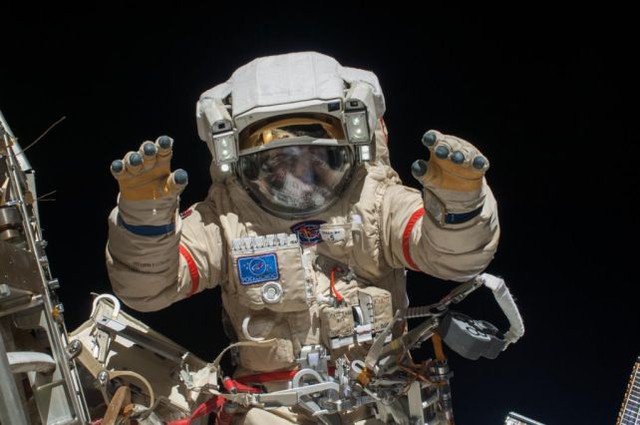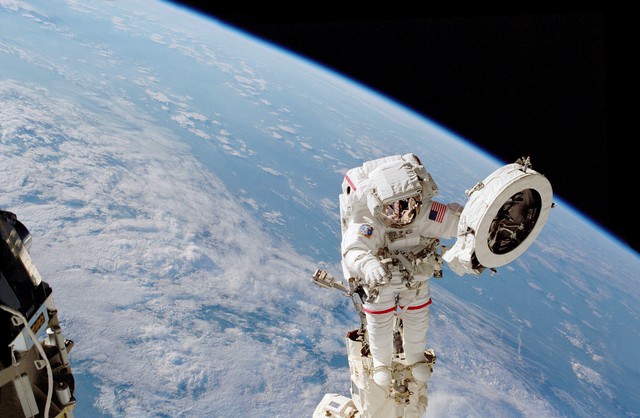
Sh:o:cking truth that few people know: Why do many astronauts l.ose all their fin.gern.ails when going into space?
It may sound unbelievable and painful, but this is a common medical problem among astronauts.
The vast universe always contains wonders and challenges beyond human imagination. The journey to conquer space is an epic about the intelligence, courage and sacrifice of astronauts. However, behind the heroic footage of historic footsteps on the Moon or complex maintenance work outside the International Space Station (ISS), few people know a "shocking" and somewhat creepy truth that many astronauts have to face: the condition of mass nail loss after spacewalks (EVA).
It may sound unbelievable and painful, but this is a common medical problem among astronauts. So, what causes this strange and worrying phenomenon? Is it possible that the harsh environment of space has a negative impact on the human body, even on seemingly small and unimportant parts like fingernails? Scientists and aerospace medicine have been working hard to find an answer to this phenomenon, and their findings have revealed the invisible pressures and challenges that astronauts face in their bulky spacesuits.
The "culprit" is called pressure and friction
The main cause of nail loss in astronauts during EVA does not come from cosmic radiation or zero gravity, but from the spacesuits designed to protect them from these dangers. More specifically, the "culprit" is the combination of pressure inside the spacesuit and the constant friction between the fingers and the fingertips of the glove.
Spacesuits are designed to maintain an environment similar to that on Earth, protecting astronauts from the vacuum and extreme pressure differences of space. This pressure affects the entire body, including the hands and fingers. When working outside the spacecraft, astronauts must perform many complex tasks that require considerable dexterity and grip strength. This results in the fingers being constantly pressed against the fingertips of the spacesuit gloves.
Spacesuit gloves, while designed to provide protection and flexibility, have certain limitations in terms of perfect fit for each individual. Small differences in hand size or shape between the astronaut and the glove can create localized pressure points. When the fingers are subjected to constant pressure and rubbing against the glove tip for hours at a time, especially when performing tasks that require grip strength, the small blood vessels under the fingernails can be damaged.
Consequences of prolonged damage
Damage to these blood vessels disrupts the supply of nutrients and oxygen to the nail cells. Over time, the nails become weak and are more likely to peel away from the nail bed. This process does not usually occur immediately during a spacewalk, but often occurs days or even weeks after the astronaut returns to Earth.
Symptoms can include swelling, pain, discoloration (often purple or black due to blood pooling under the nail), and eventually complete nail loss. This is an experience that is not only physically painful but also psychologically devastating for astronauts who have endured extreme challenges to complete the mission.
NASA researchers say: "Hand injuries are common among astronauts training for EVAs. When gloves are pressurized, they restrict movement and create pressure points during missions, sometimes causing pain, muscle fatigue, abrasions, and occasionally more serious injuries such as nail detachment. Glove injuries, both anecdotal and documented, have been reported during EVA training and flight throughout NASA's history regardless of mission or glove model.
Efforts to improve and reduce risks
Recognizing this issue, engineers and scientists at leading space agencies such as NASA and ESA have been constantly researching and developing new generations of astronaut gloves. The goal is to create gloves that fit better, are more flexible, and are able to distribute pressure more evenly across the fingers.
Some solutions that have been deployed or are in the process of being researched include custom-designed gloves using 3D scanning technology to create precise molds of each astronaut's hand, thereby creating gloves with a perfect fit. In addition, the use of advanced materials that are softer, more elastic, and have the ability to reduce friction between the fingers and the glove is also emphasized. Multi-layered designs and padding at the fingertips to reduce direct pressure on the nails, along with research into systems that allow flexible adjustment of pressure inside the glove during EVA are also promising directions.
Despite significant advances, nail loss remains a potential risk for astronauts undertaking long and complex spacewalks. Continued research and improvement of astronaut glove technology is vital to protect the health and safety of these pioneers in space exploration.
The story of nail loss may be a small detail in the larger picture of the challenges humans face when setting foot outside of Earth. However, it is a profound reminder of the harshness of the space environment and the tireless efforts of scientists and engineers to ensure the safety of brave astronauts. This "shocking" fact, although little known, is an indispensable part of the arduous but also extremely glorious history of human conquest of space.
News in the same category


The Volume Button on Your Phone Has More Power Than You Think — Here Are 3 Useful Functions Most People Miss

More People Are Developing Kidney Failure; Doctor Warns of 4 “Tox.ic Drinks” Behind the Surge: “Cut These Down Immediately”

Condolences to those who are using these 4 types of electric kettles

Boiling Water the Wrong Way? Experts Warn: These 3 Common Habits May Increase Cancer Risk for the Whole Family

Three Types of Fish That May Be “Can.cer Hotspots” — No Matter How Tasty, It’s Best to Avoid Them (The Second Is a Favorite in Many Households)

Doctors Warn: To Protect Your Pancreas, Avoid These 5 Breakfast Foods — No Matter How Hungry You Are

Why Japan Has One of the World’s Lowest Diabetes Rates Despite Eating So Much Rice — The Surprising Habit Everyone Can Learn From

Why are buttons on men’s and women’s shirts always on opposite sides?

The first animal you spot in this visual reveals your ‘worst flaw’

Tiny “Bags” on your walls? Here’s what they really are and how to get rid of them for good

Why we help waiters: The psychology behind a simple act of kindness

Say Goodbye to Joint and Foot Pain with a Relaxing Rosemary Bath

There's actually a rule, and now I finally understand the reason

Ever Wonder Why Japanese People Wear Socks to Bed All Year Round? Here’s the Surprising Reason

A Once-Discarded Leaf Now Becomes a Billion-Dong Industry as China Buys in Bulk

The Mystery of the Tiny Pocket on Jeans: 90% of Wearers Don’t Know Its Original Purpose

“I Almost Lost My Life”: A Shocking Warning for Every Household Using a Water Heater

No Scrubbing Needed: This Simple Trick Makes Your Electric Kettle Spotlessly Clean Like New

Why do flight attendants usually go to a hotel instead of going home after the plane lands?
News Post

Stir-Fried Glass Noodles with Shrimp

Grilled Chicken Rice Bowl with Corn

10 symptoms of dia.betes that may show up in your feet

5 diseases that can cause stomach pain after eating - What your body may be trying to tell you?

Loaded Cheesy Bacon Fries

Cheesy Stuffed Beef Buns (Baked Meat & Cheese Rolls)

30 Powerful Benefits of Sessile Joyweed (Alternanthera sessilis): A Traditional Plant with Remarkable Potential

Doctors warn: 6 types of food that can promote can.cer growth that people are unaware of

Why shouldn't you set the air conditioner to 26°C at night?

9 out of 10 people store onions incorrectly: Here's why you shouldn't keep them in the fridge

Smart travel tip: Why you should toss a water bottle under your hotel bed?

Don't throw away your yellowed white shirts - try this soaking method to make them bright and as good as new

Are feet an "early warning sign" of cervical can:cer? Don't ignore these 4 situations

Different Green Juices to Reduce Be.lly Fat

This is why some people always keep a lemon with them - it may help in unexpected situations

Classic Baked Lasagna

Don’t Ignore These 5 Symptoms at Night That Could Be Linked to Can.cer

Canadian Researchers Discover New Evidence That Vitamin D Shuts Down Cancer Cells

Warning: 6 vegetables that naturally contain to.xins



